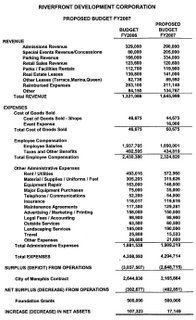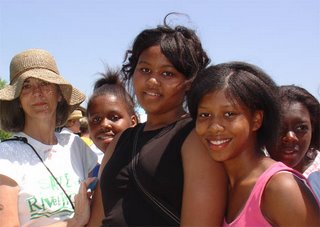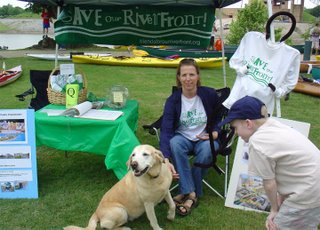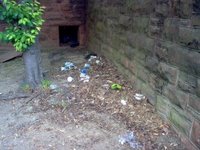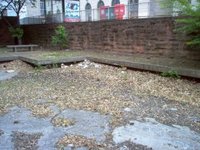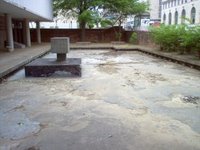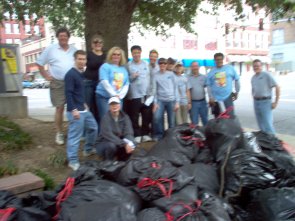You're "right" on track with the national gurus
What you've been saying you want for our riverfront and what authorities around the country are saying, are one and the same thing.
Here's a must-read article by columnist Neal Peirce on the multitude of ways cities are benefitting from parks and information about a new 4-part PBS series on how American cities are becoming more livable and attractive by reclaiming nature.
GREEN ALCHEMY
By Neal Peirce
CHICAGO -- Grimy, dark, foreboding -- underscored by urban flight and chilling film scenes, America's cities suffered negative images through much of the late 20th century.
But there's a new, green, urban alchemy. And it's on spectacular display in Chicago this spring. Reflecting Mayor Richard M. Daley's intent to make his city the greenest in America, downtown is filled with beds of flowers and blossoming pots hung from new street lamps. Some 70 miles of green roadway medians stretch out into the neighborhoods.
Chicago's signature lakefront parks are a well-tended, green expanse of intense people use. The city is spending generously to maintain and upgrade its 570 parks, 31 beaches, 518 playgrounds, 16 historic lagoons and more.
The biggest splash by far is the new Millenium Park, $475 million worth of greenery, sculpture, fountain, grass and plantings between Michigan Avenue and the lakefront, including a stunningly designed outdoor music facility that provides 50 free concerts each summer.
Since Millenium's 2004 opening, Chicagoans and visitors have poured in, close to 4 million yearly, a kaleidoscope of races, ages and classes. But the park is also a perfect fit for the new green metaphor: its exquisite plantings have replaced an open pit of railroad tracks, ugly trusses holding up railroad electric lines, and a dusty surface parking lot.
Welcome to a park junkie's paradise, Alderman Mary Ann Smith told an Urban Park and Recreation Summit of directors and advocates from major cities, gathering in Chicago last week. Since the late 1980s, she said, Chicago's new and remade parks, its flowers and public art have begin to turn around many blighted, crime-ridden neighborhoods. "We're creating places people want to be, not places people want to flee. "
In addition to the remarkable half million trees planted during Daley's tenure, many asphalt schoolyards have been converted to grass, vacant lots turned into community gardens, and trails, greenways and wildlife habitat developed along such waterways as the Chicago River.
One result: hundreds of millions of dollars of new housing, America's most dramatic "back to the city movement." Real estate values around Millenium Park alone have increased by at least $1.2 billion. Greenery has helped Chicago expand its visitor and convention industry to $9 billion in value a year.
And the phenomenon isn't Chicago's alone. Across the U.S., "there's a growing momentum - confidence that parks are no longer just a pretty face, but can drive economic development, " Trust for Public Land president Will Marshall told the parks summit.
Well-maintained parks, said John Crompton, a parks expert from Texas A & M University, "are a city's "wow" factor--everyone loves greenery around them." City councils that cut corners in park maintenance need a wake-up call, he suggested, because there's clear evidence that from the founding of New York's Central Park in the 1850s onward, parks have raised surrounding property values well above the cost of their construction.
And, Crompton said, the payoff continues. Highly-educated, professional workers -- the economic gold of these times -- gravitate to places with high quality of life, parks and recreation included. Indeed, firms in less attractive places have to struggle with "disamenity compensation" -- premium pay to draw talent.
And economics is just one reason to fight budget cuts and mobilize support for parks, the Chicago conferees proclaimed in a national "Call to Action " drawn up by the National Recreation and Park Association.
First, there's health -- fostering wellness and combatting today's scourges of obesity, diabetes and heart disease. People enjoy and keep returning to quality parks with their greenery and natural beauty, attractive pathways for walking, running and biking, and sports fields. The visitor repeat rate for parks far exceeds treadmills and other tortuous exercise machines that many people abandon after a few weeks or months.
Second, tree-studded city parks provide natural filtration for storm water runoff, reduce carbon dioxide/greenhouse gas impacts and act as natural city air conditioners in summertime, mitigating urban "heat island impacts." Each piece of raw land or brownfield recycled into parkland helps -- even in a Chicago where Daley is pushing the green envelope even further with some 200 energy-saving green roof buildings, City Hall included.
Third, parks matter immensely for youth -- outdoors play fosters children's physical and mental growth, pulling them away from a deadened life of television and video games. Among teenagers and young adults, well-run parks clearly blunt crime levels. Yet, sadly, low-income neighborhoods, with their heavy minority and immigrant populations, are seriously park-poor -- especially in cities such as Atlanta, Los Angeles and Dallas, reports Peter Harnik of the Trust for Public Land.
Will Chicago's green alchemy and focus on parks sprout across the continent? The case is compelling. But it's also a wonderful human opportunity, says Chicago's Alderman Smith -- creating and fostering better parks as safe places for children to just lie around and watch the clouds.
Click here to refresh yourself on what you've been saying all along.
And if that's not confirming enough, there's also the new PBS series EDENS LOST & FOUND, a four-part series, that WKNO unfortunately is not running now, but may schedule later.
The extraordinary stories of environmental rebirth in four very different American cities will be covered, each in a Thursday night segment. Each one-hour program examines the unique environmental, economic and social issues that each of these great cities face.
And there's a power to the people element to the good news. Interviews with citizen activists, politicians, urban planners, and urbanites reveal how passion combined with innovative strategies can address the widespread problems facing many of America's urban environments today. While these citizen activitists and politicians come from different parts of the U.S. they share a common approach. It's called Sustainable Development.
Episode One: Chicago, City of the Big Shoulders, airs May 18.
Episode Two: Philadelphia, the Holy Experiment, airs May 25.
Episode Three: Los Angeles, Dream a Different City airs Fall 2006.
Episode Four: Seattle, The Future is Now airs Fall 2006.
"The Week" in NYC picked the first segment on Chicago as last week's "Show of the Week." The film focuses on Mayor Richard M. Daley's often agressive "Green Crusade": bulldozing an airstrip into an urban oasis, building the 24-acre Millennium Park over a parking garage, and championing "green rooftops" that absorb rainfall and harbor wildlife. It also spotlights community initiatives to reclaim land for native Midwestern flora, clean up rivers, and turn slag heaps into meadows.
Let's hope WKNO will give us a chance to see them.
[Click here to read more...]


